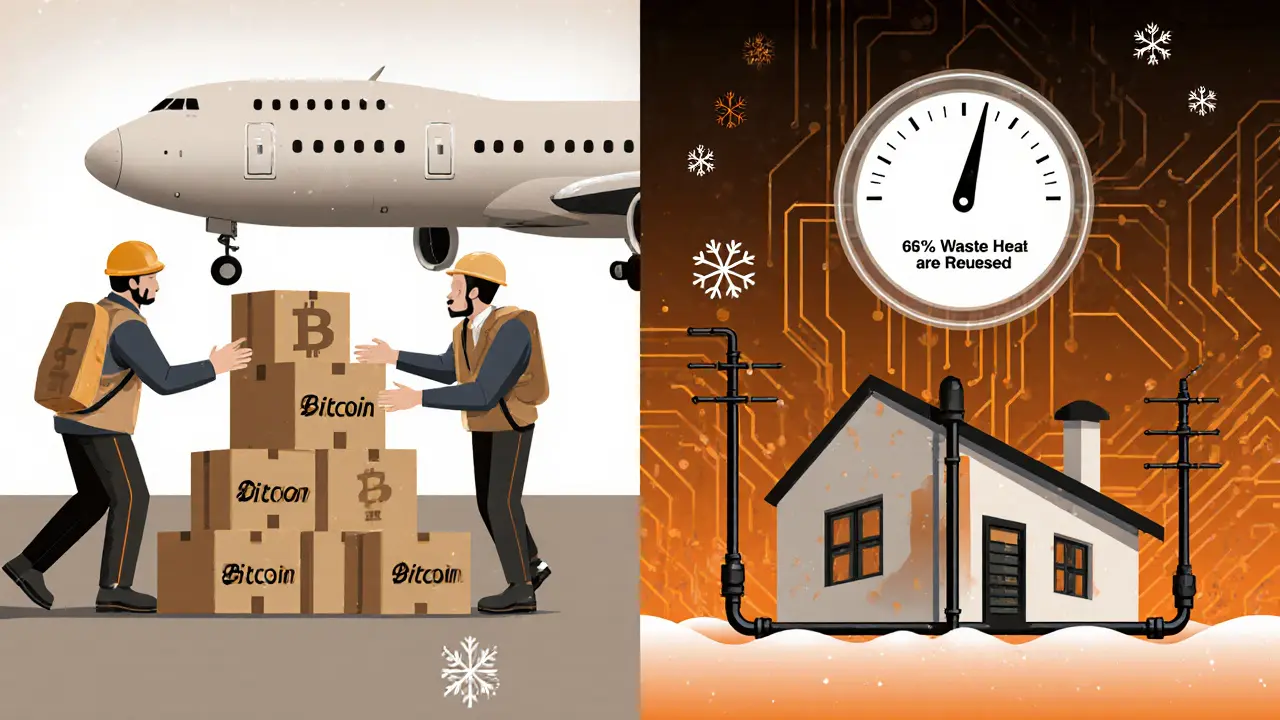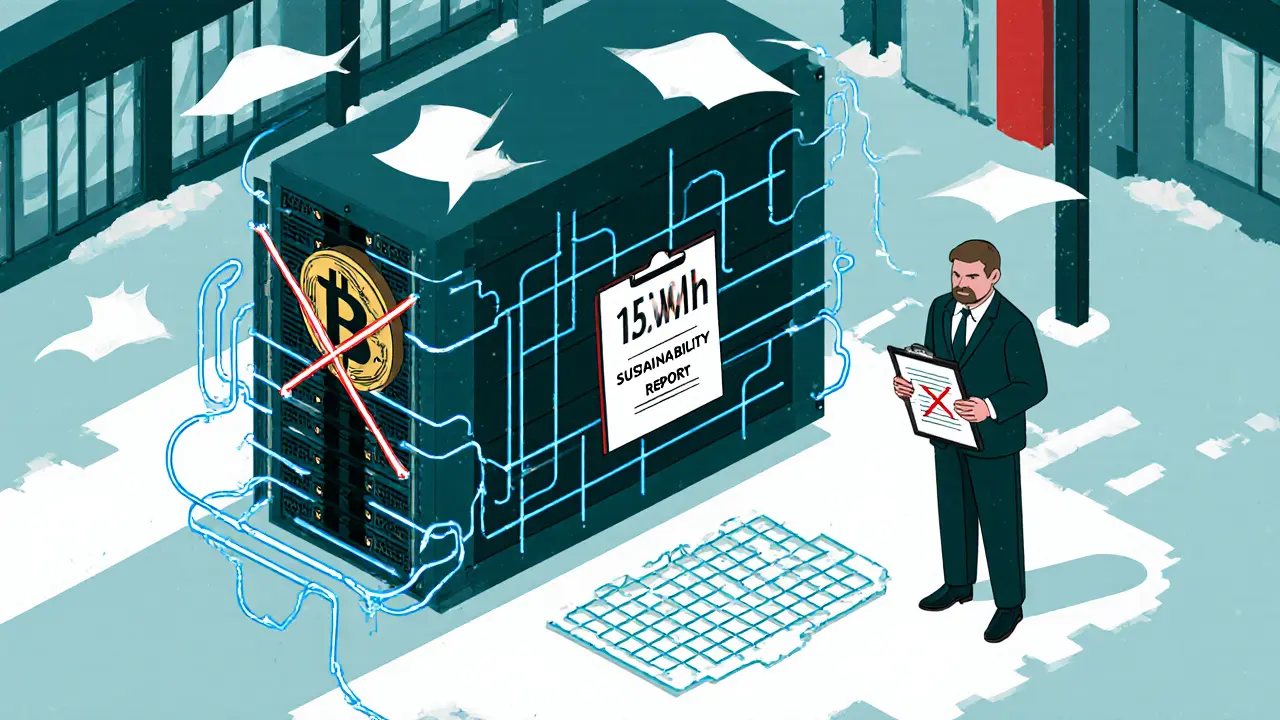Crypto Mining Energy Calculator
Enter your mining parameters to see the energy consumption and environmental impact.
Sweden isn’t banning cryptocurrency outright-but it’s making it harder than ever to mine it. While Bitcoin and other proof-of-work coins still technically operate in the country, the government has turned up the pressure so hard that many miners are packing up and leaving. The reason? Energy use. Not just any energy use-massive, unsustainable amounts of electricity that clash with Sweden’s climate goals.
Why Sweden Is Targeting Crypto Mining
In 2023, Sweden’s Financial Supervisory Authority (FI) and Financial Stability Council (FSC) made a bold move: they called for a complete EU-wide ban on Bitcoin mining. Their argument? Bitcoin’s proof-of-work system is a climate liability. At current market levels, the network releases about 120 million tonnes of CO2 every year. That’s the same as 100 million round-trip flights between Sweden and Thailand. For a country that gets over 80% of its electricity from nuclear and renewable sources, even a small increase in demand feels like a betrayal of its environmental values. Between 2021 and 2022, Bitcoin mining in Sweden jumped by several hundred percent. Why? After China cracked down on mining in 2021, operators fled to countries with cheap, abundant power. Sweden-with its cold climate, reliable grid, and low-cost hydro and nuclear energy-became a magnet. By 2022, mining was using around 1 TWh of electricity annually. That’s enough to power 200,000 homes. And it wasn’t just Bitcoin. Ethereum mining was also a major contributor before its switch to proof-of-stake in 2022.How Much Energy Are We Talking About?
The numbers are staggering. Globally, Bitcoin mining consumes about 143 TWh per year-more than entire countries like Sweden (115 TWh) and Norway (123 TWh). Sweden’s own energy use for mining has since stabilized at 1-1.5 TWh per year, but even that’s a significant burden. The Swedish Energy Agency reports that mining accounts for roughly 1.5% of the nation’s total electricity consumption. That might sound small, but it’s not. Every extra megawatt drawn from the grid means more infrastructure, more strain, and more emissions-even if the power is clean. The problem isn’t just the source-it’s the scale. Countries like Norway and Iceland welcome miners because they have surplus renewable energy. Sweden doesn’t see it that way. Its regulators focus on total consumption, not whether the power comes from wind or water. A miner using 100% hydroelectric power in Boden is still using energy that could go to homes, hospitals, or electric vehicles. That’s the core of Sweden’s stance: crypto mining is a luxury, not a necessity.What’s Actually Banned? (Spoiler: Nothing-Yet)
Contrary to headlines, Bitcoin mining is still legal in Sweden. But it’s now buried under layers of regulation. Since 2024, any mining operation above 0.5 MW must register with the FI and submit quarterly sustainability reports. These reports must detail energy sources, consumption patterns, and environmental impact using European Commission-approved formulas. Local municipalities have added their own rules: Boden caps new mines at 5 MW, Kiruna requires 90% renewable verification, and several towns now demand waste heat recovery systems. The registration process takes 4-6 months-twice as long as in Portugal or Germany. Banks, pressured by FI guidance, have started cutting off services to miners without warning. One operator in Norrbotten County lost his banking access in January 2025, even though his facility ran entirely on hydroelectric power. He wasn’t breaking any law. But he was a liability in the eyes of the financial system.
Who’s Leaving? Who’s Staying?
The exodus is real. A 2024 survey of 47 Swedish mining companies found that 68% plan to relocate by 2026. Norway is the top destination-42% of miners are moving there. Germany and the U.S. follow. Meanwhile, 22% are switching entirely to proof-of-stake models, which use 99.95% less energy than Bitcoin’s proof-of-work. Stockholm’s EcoChain startup is one success story: after switching, their energy use dropped from 2.3 GWh/year to just 1.1 MWh. They’re now profitable on transaction fees alone. The Swedish Crypto Mining Association reports mining capacity has fallen by 40% since 2022. Sweden’s share of the Nordic crypto market has dropped from 38% to 27% in just three years. Norway’s share, by contrast, has climbed to 34%. Sweden isn’t just losing miners-it’s losing its position as a tech leader in the region.Sweden’s Countermove: Regulation Over Ban
Sweden’s initial push for a full ban didn’t gain traction in the EU. But its demands did. In December 2024, the European Commission adopted new rules under MiCA requiring all crypto projects to disclose their environmental impact in public white papers. Sweden got its transparency-and then went further. In January 2025, it passed the Crypto-Asset Environmental Transparency Act, forcing large miners to publish real-time energy usage data online. The public can now see exactly how much power a mine is using at any given moment. The government also allocated 200 million SEK ($18.4 million) to develop waste heat reuse systems. In Luleå, a pilot project captured 65% of a mining facility’s excess heat and fed it into the local district heating network. That’s not just efficient-it’s circular. The same machines that validate blocks now help warm homes in winter.
Is Sweden’s Approach Working?
The data says yes. Energy use from crypto mining is projected to drop below 0.8 TWh by 2025, down from 1.5 TWh in 2022. The shift away from proof-of-work is accelerating. Ethereum’s transition killed 99.95% of its energy demand overnight. New blockchains like Solana and Cardano use proof-of-stake by default. Even Bitcoin miners are starting to explore hybrid models. But there’s a cost. Sweden’s regulatory environment is now ranked 23rd globally for crypto-friendliness-down from 12th in 2022. Startups are fleeing. Investors are wary. The Swedish Blockchain Association argues that financial regulation-like AML and KYC rules-would be enough. Why punish an entire industry for the sins of one consensus mechanism? The answer, from Sweden’s perspective, is simple: climate action can’t wait. Every kilowatt-hour wasted on mining is a kilowatt-hour not used to decarbonize transport, industry, or housing. Sweden isn’t anti-blockchain. It’s anti-waste.What’s Next for Sweden and Crypto?
Sweden’s 2025 Strategic Plan shows a shift: no more calls for a mining ban. Instead, they’re moving toward carbon pricing for energy-intensive crypto operations. Think of it like a pollution tax: the more electricity a miner uses, the more they pay. That way, clean miners stay, and dirty ones either adapt or leave. By 2027, analysts predict Sweden will evolve into a “Swiss model”-technology-neutral, outcome-focused, but still fiercely protective of its environmental standards. The goal isn’t to kill crypto. It’s to make sure it doesn’t cost the planet.For now, Sweden’s message is clear: if you want to mine here, you don’t just need a server. You need a sustainability plan, a public data feed, a waste heat strategy, and the patience to wait six months just to get a bank account. It’s not impossible. But it’s not easy either.
Is Bitcoin mining illegal in Sweden?
No, Bitcoin mining is not illegal in Sweden. However, it is heavily regulated. All mining operations above 0.5 MW must register with the Swedish Financial Supervisory Authority (FI), submit quarterly environmental reports, and comply with local municipal rules. Many miners have left due to the complexity and cost of compliance.
Why does Sweden care more about crypto energy use than other countries?
Sweden focuses on total energy consumption, not just the source. Even if a miner uses 100% renewable power, the country sees it as a drain on a grid that should prioritize homes, hospitals, and industry. Countries like Norway and Iceland have surplus energy and welcome miners. Sweden doesn’t-it’s focused on reducing overall demand to meet its climate targets.
How much electricity does crypto mining use in Sweden?
As of 2024, crypto mining in Sweden used about 1-1.5 TWh annually. By 2025, that’s expected to drop below 0.8 TWh due to mining relocation, Ethereum’s switch to proof-of-stake, and new regulations. That’s roughly 1.5% of Sweden’s total electricity use.
Can I still start a crypto mining business in Sweden?
Technically yes, but it’s extremely difficult. You need to register with FI, pass an environmental impact assessment, secure a bank account (which many refuse to provide), comply with municipal limits, and publish real-time energy data. Most new operators are choosing Norway, Germany, or the U.S. instead.
What’s the difference between proof-of-work and proof-of-stake?
Proof-of-work (used by Bitcoin) requires miners to solve complex math problems using powerful computers, which consumes massive amounts of electricity. Proof-of-stake (used by Ethereum, Cardano, Solana) selects validators based on how much cryptocurrency they hold and are willing to "stake" as collateral. It uses up to 99.95% less energy-making it the preferred model for environmentally conscious regulators.
Are Swedish banks refusing to work with crypto companies?
Yes. Many banks have severed ties with crypto mining firms, even those using renewable energy, due to pressure from the Financial Supervisory Authority. Customers report sudden account closures, withdrawal limits, and refusal of new services. This has made day-to-day operations nearly impossible for many miners.
Is Sweden’s approach influencing other EU countries?
Yes. Sweden’s push for transparency directly shaped the EU’s MiCA regulation, which now requires all crypto projects to disclose their environmental impact. While no other country has gone as far as Sweden’s real-time data rules, the trend toward stricter environmental reporting is spreading across the bloc.
What’s happening to blockchain innovation in Sweden?
While energy-intensive mining is declining, Sweden remains a hub for enterprise blockchain. Stockholm hosts 37% of Nordic blockchain startups focused on supply chains, identity verification, and public sector applications-none of which rely on proof-of-work. The Kista Science City tech hub supports over 120 blockchain companies, showing that innovation can thrive without mining.

anthony silva
November 16, 2025 AT 06:11So Sweden banned mining but still lets people run 5000 AC units in their mansions? Cool logic.
Also why is a country with more nuclear plants than a sci-fi movie suddenly worried about a little electricity?
Next they'll ban toaster ovens because they might use 0.0001% of the grid.
Mandy Hunt
November 16, 2025 AT 07:58theyre not banning mining theyre banning freedom
you think this is about climate
its about control
they want to decide who gets power and who doesnt
and if you dont play nice with their rules you disappear
just like the old USSR but with more spreadsheets
Liz Watson
November 17, 2025 AT 09:39Oh wow a whole country that cares about the environment? How quaint.
Meanwhile in the US we're still burning coal to power Bitcoin while watching reality TV.
Sweden's basically the only adult in the room and you're mad because they won't let you run a giant space heater in the middle of winter.
Good luck with that.
Mauricio Picirillo
November 19, 2025 AT 01:04the fact that people still think mining is just about crypto is wild
its about energy use period
if you need 100 homes worth of power to validate transactions
then maybe the tech needs to evolve
not the planet
ethereum already proved it can be done
and now its cheaper and faster
so why fight it?
its not anti-tech its pro-smart
David Cameron
November 19, 2025 AT 10:02Sweden isn't against crypto
its against the idea that infinite growth on a finite planet is acceptable
we treat energy like its infinite
like its free
like the Earth owes us more
but it doesnt
mining is a symptom of a deeper problem
we dont value efficiency
we value spectacle
and thats why we keep building these digital furnaces
even when we know they dont need to exist
Hamish Britton
November 19, 2025 AT 22:01heard about that heat reuse project in Luleå
that’s actually kinda brilliant
imagine your rig warming your neighbor’s apartment
not just powering a blockchain
but helping people stay warm
that’s tech with purpose
not just profit
maybe we should be asking how to make mining useful
not just stop it
Sara Lindsey
November 20, 2025 AT 14:10yes yes yes
this is the future
not mining for the sake of mining
but using tech to solve real problems
heat reuse
clean energy
transparency
why are we still arguing about this
we have the tools
we just need the will
and Sweden is showing us how
no drama
no hype
just smart choices
go Sweden
Gavin Jones
November 20, 2025 AT 21:39It is, perhaps, worth noting that the regulatory framework Sweden has implemented is not merely punitive, but structurally innovative. The real-time energy transparency mandate, for instance, represents a paradigm shift in accountability. One might argue that such transparency is not only prudent, but ethically imperative in an era of climate urgency. The notion that compliance equates to hostility is, frankly, a misreading of the intent. Sweden is not seeking to extinguish innovation; it is demanding that innovation align with planetary boundaries. This is not obstructionism. It is stewardship.
Rachel Anderson
November 21, 2025 AT 05:28imagine your life being worth less than a server farm
that’s what this is
they don’t care about your dreams
they care about their carbon footprint
and they’re willing to crush your business
your livelihood
your entire future
just so they can feel morally superior
while sipping organic oat milk in their zero-waste apartment
and calling it justice
its not justice
its punishment
and its ugly
alex piner
November 22, 2025 AT 10:18im still not sure why people are so mad
if you can make money without wrecking the planet
why not do it
ethereum switched and theyre still rich
so why fight it
its like refusing to use solar panels because you like coal
its not about hating tech
its about not being lazy
and honestly
if your business needs to burn a whole town’s power to work
maybe its not the future